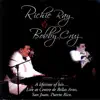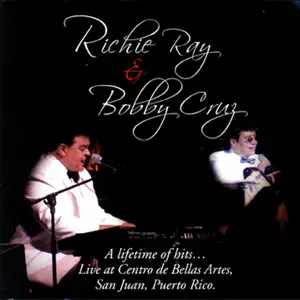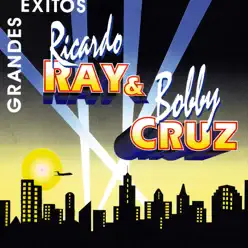


Acerca de Richie Ray y Bobby Cruz
Salsa’s beautiful duo comprised Ricardo ‘Richie’ Ray (b. Ricardo Maldonado, 15 February 1945, Brooklyn, New York, USA, of Puerto Rican parentage; co-band leader, composer, multi instrumentalist) and Bobby Cruz (b. Roberto Cruz, 26 February 1941, Hormigueros, Puerto Rico; co-band leader, singer, composer, arranger, güiro, maracas). Ray and Cruz have been partners for over 25 years. Ray began playing the piano at the age of seven. In 1957 he played bass in a group led by Cruz. Ray attended the Brooklyn Conservatory of Music, High School of Performing Arts and Juilliard School of Music. He left the latter after a year to devote himself fully to his newly formed band, which included Cruz on lead vocals. Ray signed with Fonseca Records and debuted on Ricardo Ray Arrives/Comején in 1964. The title track ‘Comején’ (co-written by Ray and Cruz) was a hit and the album included the outstanding ‘Mambo Jazz’, which the two performers reworked on several future releases. The duo recorded some of their very finest work during their period with the label. The follow-up, On The Scene With Ricardo Ray, contained a delightful version of Bud Powell’s ‘Parisian Thoroughfare’, which changed midway through from a cool Latin jazz piece to a driving mambo. Notable accompanists on these early releases included Ricardo’s brother, trumpeter Ray Maldonado, bass player/arranger Russell ‘Skee’ Farnsworth and vocalist Chivirico Dávila. Ray had a crossover hit in the black American community with ‘Jango’ from 1966’s 3 Dimensions.rrnRichie switched to Alegre Records and released nine albums (including a compilation) on the label between 1966 and 1970. He was one of the first artists to record the R&B/Latin fusion style called boogaloo. He described his Alegre debut, Se Soltó/On The Loose/Introducing The Bugaloo, as ‘too musical’ and ‘ahead of its time’ (quoted in Latin NY magazine, c.1968). The more deliberately commercial follow-up, Jala Jala Y Boogaloo, contained one of his greatest hits ‘Richie’s Jala Jala’, co-written by Ray and Cruz. While still under contract to Alegre, Ray recorded Viva Ricardo and El Diferente for UA Latino, which was a division of United Artists Records. The latter included the marvellous ‘Feria En Manizales’. In 1968, Los Durísimos/The Strong Ones/Salsa Y Control was the first album on which Cruz shared equal billing with Ray. At this stage, the band had an eight-piece line-up of Venezuelan Pedro Rafael Chaparro and jazz musician Doc Cheatham (trumpets), Farnsworth (bass/co-arranger), José ‘Candido’ Rodríguez (timbales), Jackie ‘El Conde’ Dillomis (conga), Harry ‘Bongo’ Rodríguez (bongo), Ray (piano/co-arranger) and Cruz (lead vocals). Ray and Cruz continued to use an all trumpet frontline, and later added flügelhorn on occasions. The two-some enjoyed considerable success in Colombia in the late 60s and their sound had a significant influence on the country’s own variant of salsa. Their fifth Alegre release, Let’s Get Down To The Real Nitty Gritty, featured the single ‘Nitty Gritty’ which had some success in the UK.rrnIn 1970, the duo relocated from New York to Puerto Rico. ‘The competitiveness of the Latin bands in New York was becoming too rough and we had grown tired of this city’s circuit... (and Bobby) just didn’t want his children to develop in this city’s environment’, Ray explained in Latin NY in 1976. Meanwhile their former trumpeter, Pedro Rafael Chaparro, who worked previously with Pérez Prado, Tito Puente, Machito and Tito Rodríguez, made his recording debut as leader on Este Es Chaparro (1971) on Ralph Cartagena’s Rico Records. His band on the album included three ex-Ray and Cruz players: Cheatham, Farnsworth and Dillomis. Only Cheatham remained on Chaparro’s Gozando in 1974, which featured Israel ‘Cachao’ López on bass. Ray and Cruz experienced some initial hardships after their arrival in Puerto Rico, but the bookings soon came pouring in. Their financial success enabled them to open a nightclub in Santurce, a district of Puerto Rico’s sprawling capital, San Juan. However, running the club in addition to their heavy gigging schedule proved to be too great a strain. So they sold the club and concentrated on playing the island circuit.rrnRay and Cruz signed with the newly created Vaya Records, a subsidiary of Jerry Masucci and Johnny Pacheco’s Fania Records. Their output on Vaya during the 70s and 80s was uneven in quality, but there was the occasional redeeming moment of interest. The Puerto Rico-recorded El Bestial Sonido De... Ricardo Ray Y Bobby Cruz (1970), the first ever release on Vaya, was one of their better albums on the label. It featured 18-year-old female vocalist Miki Vimarí and contained the Rubén Blades composition ‘Guaguanco Triste’. The 1972 Vimarí showcase, Ricardo Ray Presenta A La Vimarí, was a disappointing set of slow sentimental numbers. However, 1973’s Jammin’ Live, with Vimarí as co-lead singer, was a commendable album. In 1974, Ray entered a period of emotional turmoil, which led to alcohol and drug abuse. He had several religious experiences and announced in August of that year that he had converted to a brand of evangelical Christianity. Ray’s new spiritual concerns took precedence over gigging and initially caused friction with Cruz, but after a short while, he too became a convert. They began to make specifically religious recordings, as well as proselytize through their ‘regular’ salsa recordings - what UK salsa broadcaster Tomek called ‘salsa with beatitude’. They also started crusading via concerts. 1975’s Reconstrucción won them their ninth gold disc, which was presented at Madison Square Garden, New York, in June 1980. The recording was directed by Louie Ramírez, who also arranged one track. The album contained their smash hit single ‘Juan En La Ciudad’, which they co-wrote. 1977’s Viven! included the exciting ‘El Rey David’, another joint composition. Their second release in 1980, De Nuevo ‘Los Durísimos’ Again, included the swinging ‘Yo Soy La “Zarza”’, which they co-penned. Doc Cheatham returned to provide trumpet solos to the duo’s three albums issued in 1981 and 1982. Ray and Cruz’s final release on Vaya, the Miami recorded Los Inconfundibles (1987), featured the magnificent ‘Sipriano’, composed by Cruz.rrnUnlike most of their peers, the extent of Ray and Cruz’s work with other Latin artists and bands had been very limited, especially since their conversion. Ray appeared on the 1966 Tico All-Star’s descarga (Latin jam session) recordings at New York’s Village Gate and on the Fania All Stars’ 1968 album debut (two volumes). Between 1971 and 1976, the duo recorded with the Fania All Stars and appeared in the Jerry Masucci movies Our Latin Thing (Nuestra Cosa), 1972, and Salsa (1976). The pair produced Chivirico Dávila’s 1978 release Nuevos Conceptos/New Concepts. Ray guested on a cover of Joe Jackson’s ‘Cancer’ on Héctor Lavoe’s Revento in 1985. In 1991, Ray and Cruz appeared on the bill of a tribute concert at El Campín Stadium, Bogotá, Colombia, to mark superstar Joe Arroyo’s 20th anniversary in the music business. That year, the pair made their farewell appearance at the first part of the annual New York Salsa Festival at Madison Square Garden.
Discografía de Richie Ray y Bobby Cruz
17 discos

Grandes Éxitos - Ricardo Ray y Bobby Cruz
2015

Grandes Éxitos de Ricardo Ray y Bobby Cruz
2015

Grandes de la Salsa: Richie Ray y Bobby Cruz
2015
Ver todos los discos
Canciones más vistas de
Richie Ray y Bobby Cruz en Abril
Top Artistas
Nosotros
Notas
